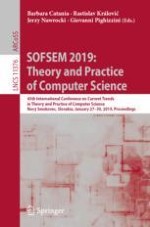2019 | Buch
SOFSEM 2019: Theory and Practice of Computer Science
45th International Conference on Current Trends in Theory and Practice of Computer Science, Nový Smokovec, Slovakia, January 27-30, 2019, Proceedings
herausgegeben von: Barbara Catania, Rastislav Královič, Jerzy Nawrocki, Giovanni Pighizzini
Verlag: Springer International Publishing
Buchreihe : Lecture Notes in Computer Science
